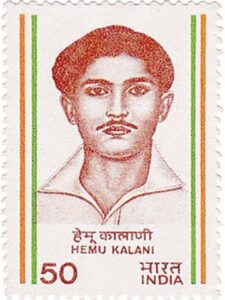 Hemu Kalani, a name etched in the annals of India’s fight for independence, stands as a testament to the unwavering spirit of youth against colonial rule. Born on March 23, 1923, in Sukkur, Sindh (present-day Pakistan), to a Sindhi Jain family, Hemu’s patriotism blossomed at a young age. He actively advocated for the boycott of foreign goods, promoting the use of indigenous products (Swadeshi) alongside his friends.
Hemu Kalani, a name etched in the annals of India’s fight for independence, stands as a testament to the unwavering spirit of youth against colonial rule. Born on March 23, 1923, in Sukkur, Sindh (present-day Pakistan), to a Sindhi Jain family, Hemu’s patriotism blossomed at a young age. He actively advocated for the boycott of foreign goods, promoting the use of indigenous products (Swadeshi) alongside his friends.
Fueled by his ardent desire for freedom, Hemu emerged as a leader within the Swaraaj Sena, a student organization affiliated with the All India Students Federation (AISF). He actively participated in protests against the British Raj, including the iconic Quit India Movement of 1942. His revolutionary fervor didn’t stop at protests; Hemu fearlessly engaged in daring acts like sabotaging British military supplies.
On a fateful night of October 23, 1942, under the full moon’s gaze, Hemu, along with two companions, embarked on a mission to derail a train carrying crucial supplies and troops for the British army. Their plan? To remove the fishplates that secured the railway tracks near Sukkur. However, lacking specialized tools, they resorted to using ropes to loosen the fastenings. Tragically, their attempt was detected by the watchful British forces.
While his friends managed to escape, Hemu’s unwavering commitment to the cause led him to stay behind. He was apprehended by the police and subjected to brutal torture in a desperate attempt to extract the names of his comrades. Despite the excruciating ordeal, Hemu remained stoic, refusing to betray his fellow revolutionaries.
This unwavering defiance resulted in a death sentence for treason. A public outcry ensued, with the people of Sindh petitioning the Viceroy for clemency. In exchange for a written apology and the names of his accomplices, Hemu could have escaped the gallows. However, his spirit remained unbroken. He refused to compromise his principles or endanger his comrades, choosing death over dishonor.
Hemu’s unwavering stance had an unexpected effect. He reportedly embraced his death sentence with remarkable joy, even gaining weight in the days leading to his execution. On January 21, 1943, just two months shy of his 20th birthday, Hemu walked to the gallows with a smile, chanting slogans of freedom. He even held the holy Bhagavad Gita, a sacred Hindu scripture, in his hands.
Hemu Kalani’s sacrifice resonated deeply, earning him the title of “Bhagat Singh of Sindh,” a reference to another iconic young revolutionary of the Indian independence movement. He stands as a symbol of courage, unwavering resolve, and the immense power of youthful idealism in the fight for freedom.
Hemu’s legacy continues to inspire generations. In 1983, the then Prime Minister of India, Indira Gandhi, released a commemorative stamp in his honor at the Vishwa Sindhi Sammelan, a global gathering of the Sindhi community.

